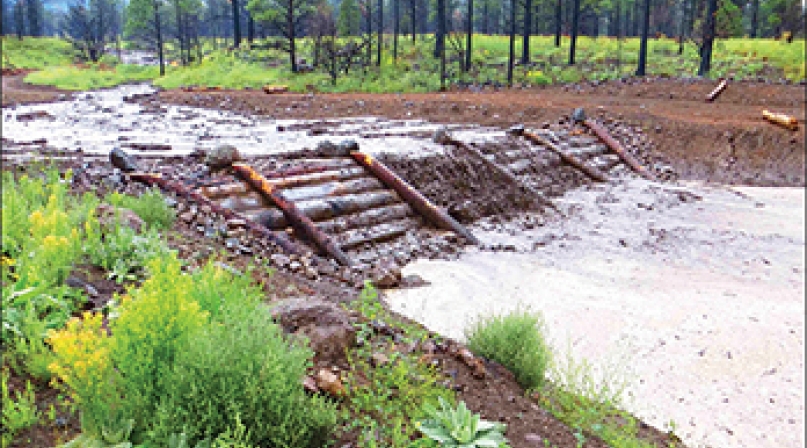Share
Line: | @NACoTweets: The damage caused by wildfires continues long after they have been extinguished. |
The 2015 wildfire season has been labeled among the most destructive in the past two decades. More than 8.8 million acres have burned. Homes have been destroyed and lives lost. Yet, after the fires are extinguished and the smoke clears, the problems associated with wildfires are far from over.
Fueled by large accumulations of dry brush and other matter, wildfires cause significant long-term environmental damage such as deforestation, soil erosion and changes in the make-up of the ecosystem’s plant and animal species. For some communities, damage to the soil can be especially dangerous: When plants burn and their roots are degraded, the resulting destabilized soil can lead to more frequent and harmful mudslides, landslides and floods. In 2010, for example, massive flooding following a wildfire occurred in Coconino County, Ariz.
In June 2010, the Schultz Fire burned 15,000 acres in Coconino County. Mountainous terrain, which is the natural watershed for the county residents living in neighborhoods downhill, was torched by the intense blaze, leaving behind a burned and desolate landscape. Just two weeks after the fire — nowhere near enough time for the county to adequately re-stabilize the soil in the area — monsoon rains flowed straight down the scorched mountainside and led to massive flooding in the neighborhoods below.
While the fire had not destroyed any buildings or lives, the ensuing flood severely damaged many homes and claimed the life of a 12-year-old.
After the initial firefighting and flood response, the county embarked on an effort to address the long-term causes and consequences of the disaster. Officials, working with county residents, determined that environmental restoration was the best approach. “We identified the opportunity to restore the watershed,” explained Lucinda Andreani, deputy director, Coconino County Public Works Department. “We wanted to restore the mountain to its natural state so that water would never again flood the neighborhoods below the watershed.”
Restoration was best for the long-term environmental health of the area, and it also mirrored the community’s values, where the region’s natural heritage is prized, she said.
The county collaborated with scientists and other experts from across the country on its restoration efforts. Restoration involved filling in eroded flood channels called alluvial fans, where water naturally spreads out. The mountain’s alluvial fans were eroded up to 25 feet in some places. “We had to fill those channels back in,” said Andreani. “Normally, it would take 50 to 75 years for those channels to fill in naturally. We studied fires from 60 to 70 years ago and developed a plan to mimic the natural cycle of sediment absorption, restoring our alluvial fans in five years instead of 50.”
In addition to restoring sediment to the eroded channels, Coconino County stabilized the alluvial fans with underground logs that force water flowing in concentrated streams to spread out. The county has also reseeded the watershed with natural vegetation. “Absorption of water has been amazing, and we’re getting nice regrowth,” Andreani said.
The restoration project is almost complete, with a thinning project of one strip of trees still underway. To fund the massive, five-year effort, the county used county funds and funding from the Natural Resources Conservation Service, the U.S. Forest Service and the Federal Emergency Management Agency.
“We’ve raised millions of dollars — it’s unheard of to raise the amount we needed,” explained Coconino County Supervisor Liz Archuleta. “The restoration plan we presented was innovative, and people wanted to help.”
The county initially spent around $10 million to fight the Schultz fire and an additional $30 million on mitigation. “One of the key messages from our experience is that there’s a cost after the fires that isn’t always considered,” Andreani said. “In this case, it was triple what it was to fight the fire.” What’s more, in a study of the full cost of the fire, the Ecological Restoration Institute at Northern Arizona University estimated that the true total cost was between $133 million and $147 million — a large portion of which was due to the devaluation of properties in the flood zone.
Another key takeaway is that the area’s fire and flood risk has decreased dramatically.
“Water has not overwhelmed the measures we’ve put in place,” Archuleta explained. “We’re protecting people’s lives, and we’re also protecting county infrastructure. Rather than spending millions of dollars on road cleanup every year, we looked long-term. We won’t constantly have to do road maintenance after floods.”
What’s more, she added, the county does not have to mobilize massive resources every time the area experiences heavy rain. Officials can monitor the situation, but there has been no flood runoff from the watershed area.
Coconino’s project has had wider-reaching effects as well, helping to promote environmental protection in other communities. The county seat of Flagstaff, after seeing Coconino County’s success, passed a ballot measure two years after the Schultz Fire to raise money for its own forest health projects.
“If the same thing had happened in Flagstaff,” Archuleta said, “the impact would have been over $1 billion because there’s so much more development than in Coconino County.
“Their ballot passed with about 75 percent of the vote.”




